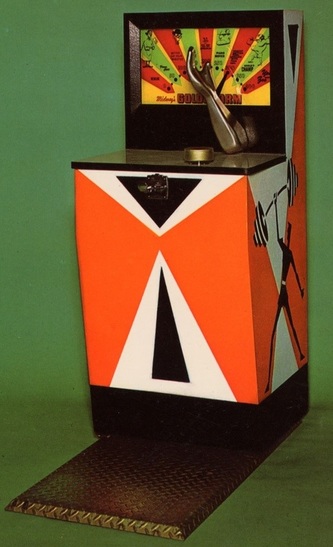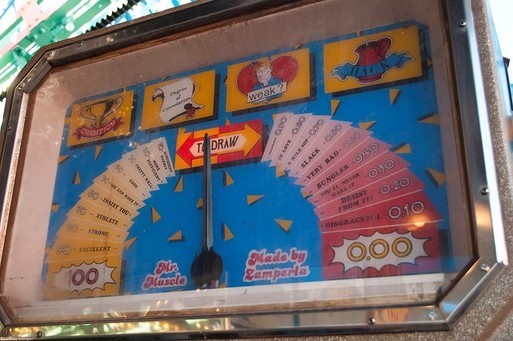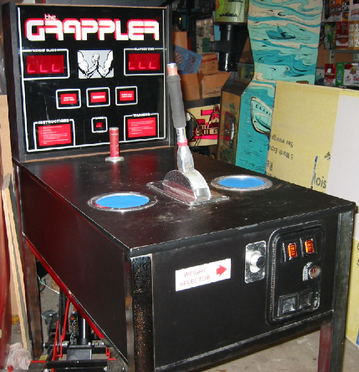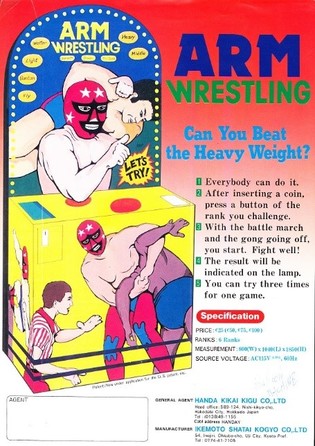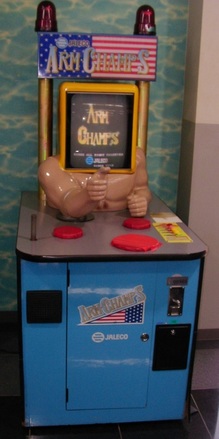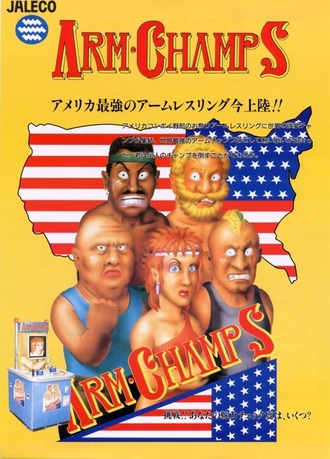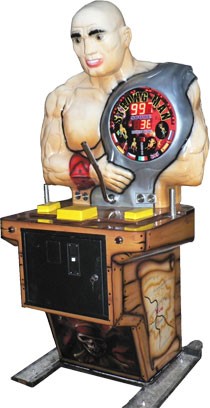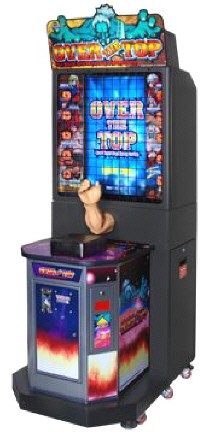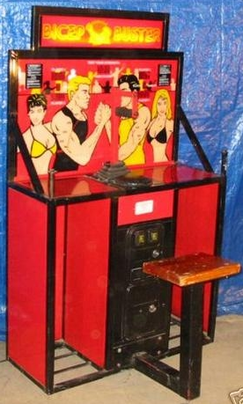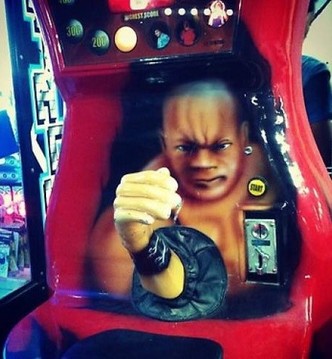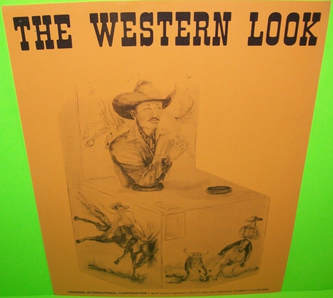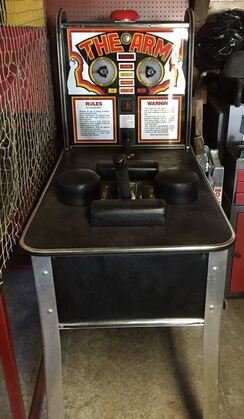Armwrestling Amusement Devices: The Best Machines in the Arcade
Coin-operated strength-testing amusement devices have always had a particular allure for me. Whenever I come across one at an arcade or a fair, I still feel compelled to try it out to prove to myself, and to anyone else who may be watching, that I’m sick strong. I always hope to reach the “He-Man”, “Gorilla”, or “Superman” level, but realize that depending on the machine’s setting, a less impressive result like “Loverboy” is a possibility.
I like grip strength testers, but my favourite devices are the armwrestling machines: specifically, the ones where you must grab a mechanical arm or lever and pull it down to hopefully show everyone that you’re the boss. I’ve seen and tried a few of these over the years, and thought it would be interesting to see just how many different types of these devices are out there. It turns out, there are quite a few…
The earliest coin-operated armwrestling machine of which I’m aware is the Golden Arm, which came out in June 1969. It was developed by Midway Manufacturing, an American company that made mechanical arcade games. The game consists of a metal lever, with a handle in the rough shape of a hand that the player must grasp and pull down. Depending on the player’s strength, the device assigns one of the following results:
- Weakling;
- Flower Child;
- Better eat your “Wheaties”;
- Banana Crusher;
- O.K. as a lover but stay away from your mother-in-law;
- Piano Mover;
- Noboby better fool around with your gal;
- World’s Champ; or
- You belong in a zoo.
Due to the simplicity of the Golden Arm’s design, it’s not unusual to see refurbished versions with customized artwork.
My personal favourite armwrestling machine—and the one I’ve competed against the most times—is the Mr. Muscle machine. Most of these were manufactured in the ‘80s by Zamperla, an Italian amusement device company. There were two types of Mr. Muscle machines: those that featured four strength levels, and those that featured eight strength levels. The look of the machines was always very similar, with a huge-armed tough-looking guy flanked by two cheering women. However, minor tweaks to the appearances of these characters were common. There were also marquee variations.
My personal favourite armwrestling machine—and the one I’ve competed against the most times—is the Mr. Muscle machine. Most of these were manufactured in the ‘80s by Zamperla, an Italian amusement device company. There were two types of Mr. Muscle machines: those that featured four strength levels, and those that featured eight strength levels. The look of the machines was always very similar, with a huge-armed tough-looking guy flanked by two cheering women. However, minor tweaks to the appearances of these characters were common. There were also marquee variations.
When competing against Mr. Muscle, the player first chooses the desired strength level and then tries to pull Mr. Muscle’s arm down within a set period of time. Three outcomes are possible: a win, a loss, or a draw. Within these outcomes, there are result sub-categories, depending on where the mechanical arm is positioned when the time elapses.
Mr. Muscle’s arm is powered by hydraulics, and the difficulty setting can be adjusted. I once played an 8-level version where just the fourth level seemed near impossible.
Another armwrestling machine which is seldom seen is The Grappler, introduced by Canadian company Gametek Systems in 1988. From afar, The Grappler resembles a pinball machine with a lever sticking out of it. To test his strength, the player first selects a weight class. He then places the elbow of his competing arm on one of the circular cups and grasps the lever. He grabs a peg with his non-competing hand. He then tries to lower the lever using side-pressure. As with most other machines, there is a time limit.
Mr. Muscle’s arm is powered by hydraulics, and the difficulty setting can be adjusted. I once played an 8-level version where just the fourth level seemed near impossible.
Another armwrestling machine which is seldom seen is The Grappler, introduced by Canadian company Gametek Systems in 1988. From afar, The Grappler resembles a pinball machine with a lever sticking out of it. To test his strength, the player first selects a weight class. He then places the elbow of his competing arm on one of the circular cups and grasps the lever. He grabs a peg with his non-competing hand. He then tries to lower the lever using side-pressure. As with most other machines, there is a time limit.
The Grappler is different from most other armwrestling devices in that it can be used by either arm (to the delight of lefties).
The Grappler was only produced for a short amount of time. Gametek Systems was actually listed on the Vancouver Stock Exchange in late 1987 and the company was projecting $60 million in after-tax profits within three years (perhaps banking on armwrestling being elevated in the public conscience following the release of Over the Top in movie theatres earlier that year). The stock soared, but came crashing down once it became public knowledge that the company had failed to disclose the fact it had been sued by a) the inventor of the machine who hadn't been paid what he had been promised and by b) two men who broke their arms when using it! The stock was soon de-listed.
Though The Grappler may not have been produced for a very long time in North America, a German version of the game (Herkules) was developed. I don’t have any information on when this occurred, but here’s a picture of the game:
The Grappler was only produced for a short amount of time. Gametek Systems was actually listed on the Vancouver Stock Exchange in late 1987 and the company was projecting $60 million in after-tax profits within three years (perhaps banking on armwrestling being elevated in the public conscience following the release of Over the Top in movie theatres earlier that year). The stock soared, but came crashing down once it became public knowledge that the company had failed to disclose the fact it had been sued by a) the inventor of the machine who hadn't been paid what he had been promised and by b) two men who broke their arms when using it! The stock was soon de-listed.
Though The Grappler may not have been produced for a very long time in North America, a German version of the game (Herkules) was developed. I don’t have any information on when this occurred, but here’s a picture of the game:
Arm Wrestling was a machine made by the Ikemoto Shatai Kogyo Company of Japan. It is believed to be from the ‘80s. Based on the art featured on the machine, I’m not sure if the manufacturer really knew what armwrestling was all about…
Like most armwrestling machines, the principle of the game is quite simple. You simply select one of six weight classes (fly, bantam, light, welter, middle, heavy) and then try to pin the arm down. You can try up to three times, changing the weight class in between bouts if you wish.
Arm Champs, manufactured by Japanese firm Jaleco in 1998, was the first strength testing armwrestling machine to feature a video game opponent. One of five different opponents of progressive strength can be selected: women’s champion and British professional wrestler Nessie Papillon (1), an unemployed German (2), Chinese fisherman Choyonpin (3), a South African miner named Mike Robinson (4), and American truck driver Wolf Adams (5).The game offers two types of play—tournament mode where you keep pulling progressively difficult opponents until you lose, or regular mode where you select your opponent in advance. You have three attempts in regular mode, and can change opponents between matches.
Arm Champs, manufactured by Japanese firm Jaleco in 1998, was the first strength testing armwrestling machine to feature a video game opponent. One of five different opponents of progressive strength can be selected: women’s champion and British professional wrestler Nessie Papillon (1), an unemployed German (2), Chinese fisherman Choyonpin (3), a South African miner named Mike Robinson (4), and American truck driver Wolf Adams (5).The game offers two types of play—tournament mode where you keep pulling progressively difficult opponents until you lose, or regular mode where you select your opponent in advance. You have three attempts in regular mode, and can change opponents between matches.
Arm Champs is thought to have only been distributed in Japan.
Arm Champs II, on the other hand, is one of the most commonly seen armwrestling machines. Released in 1992, like its predecessor the opponents appear on a video screen and the player pulls on a mechanical arm. There are nine different opponents of increasing strength from which to choose:
Arm Champs II, on the other hand, is one of the most commonly seen armwrestling machines. Released in 1992, like its predecessor the opponents appear on a video screen and the player pulls on a mechanical arm. There are nine different opponents of increasing strength from which to choose:
- Trixie, a Russian female bodybuilder
- Chang, a Taiwanese street performer
- Atlas, the prince of the planet “Amusement”
- Turk, an Egyptian retired soldier
- Duke, an American ex-champion professional boxer
- The Rock, an English fast-footed wrestler
- Goliath, a French bodybuilder
- Shibayama, the strongest sumo wrestler from Japan
- Specks, an American robo armwrestler
There are actually four different versions of Specks, each progressively stronger, with the red version being the strongest. At the end of regular play, there is a bonus stage where the player’s strength is measured in pounds of pressure exerted against the arm.
When the game was first released, reports of broken arms soon surfaced. Over a two-week span, five teenagers broke their arms playing the game in Hong Kong. Apparently, there was a sign indicating that players played at their own risk. Unfortunately, the signs were in English and they only spoke Chinese!
Not surprisingly, a Popeye-themed armrwrestling machine was eventually developed. With his huge forearms, Popeye could naturally be assumed to be a strong armwrestler. Pan Amusements, a UK-based manufacturer of amusements devices, created Popeye likely some time in the ‘80s. It in unknown if the machine was distributed in North America, but a fair number could be found in UK arcades at the time. It’s quite a good looking machine:
Not surprisingly, a Popeye-themed armrwrestling machine was eventually developed. With his huge forearms, Popeye could naturally be assumed to be a strong armwrestler. Pan Amusements, a UK-based manufacturer of amusements devices, created Popeye likely some time in the ‘80s. It in unknown if the machine was distributed in North America, but a fair number could be found in UK arcades at the time. It’s quite a good looking machine:
A couple of Polish game manufacturers introduced armwrestling machines in the past few years. Arm Wrestler is made by Jakar. To play the game, one sits on a tree stamp and grips up against an odd-looking fellow who has a big upper arm, but a puny lower arm by comparison. There are three different strength levels, and the machine features various funny sounds and messages that taunt the player. The machine comes in a few different versions.
Strong Man is another Polish game that was first introduced by X-Line Ltd. in 2007. In this game, the player puts his elbow on a pad, grasps a lever (rather than an arm), and attempts to pull it down as hard as possible. The game allows for both left and right hand play. The large, muscular figure holds what appears to be a championship belt over his shoulder, on which the player’s score is projected. The machine comes in two versions: one with a white man and one with a black man. The base of the machine can be fully customized to feature any art the buyer of the machine wants.
A Japanese armwrestling machine by the name of Arm Spirit was introduced by Atlus Co. in early 2007. The concept was similar to the other Japanese machines (Arm Champs and Arm Champs II) whereby the player grasps an arm and the rest of the opponent’s body is represented on a video screen. Players would be matched up against progressively stronger opponents, including a Chihuahua, a French maid, and a drunken martial arts master before finally facing off with a professional wrestler. (Again with the pro wrestlers!)
The game was distributed to 150 arcades across Japan before it was recalled less than one month later due to reports of three players breaking their arms when using the machine. Following the incidents, an Atlus spokeswoman said "The machine isn't that strong, much less so than a muscular man. Even women should be able to beat it," in effect adding insult to injury to the three poor young men!
One of the most recent armwrestling machines to hit the market is Over the Top, made by South Korean firm Andamiro. It appears to be very similar in style and concept to Arm Spirit, with a mechanical arm, video screen, and variety of opponents.
One of the most recent armwrestling machines to hit the market is Over the Top, made by South Korean firm Andamiro. It appears to be very similar in style and concept to Arm Spirit, with a mechanical arm, video screen, and variety of opponents.
Yet another machine by the name of Arm Champs was recently developed by Chinese company I-Play. The machine has a futuristic look to it and a robotic-like arm is grasped rather than a human-like arm. Players can face off against two opponents before they then pull on the arm to record their maximum strength.
The machine looks very similar to Jaleco’s Arm Champs II. It makes me think that the two companies are somehow related.
Other coin-operated armwrestling machines exist, as evidenced by the following pictures that I found online. Unfortunately, I have very little or no information about them.
Bicep Buster appears to be a sit-down game where the player pulls on a bar. The machine can record up to four people at a time on the scoreboard.
Other coin-operated armwrestling machines exist, as evidenced by the following pictures that I found online. Unfortunately, I have very little or no information about them.
Bicep Buster appears to be a sit-down game where the player pulls on a bar. The machine can record up to four people at a time on the scoreboard.
The Challenger and Muscle Master appear to be stand-up variations of Bicep Buster. I suspect they were probably made by the same company.
I don’t even know the name of this one:
The forearm does look a bit wimpy, sort of like the arm of the Polish “Arm Wrestler” machine. Maybe this is an older version?
***New Addition – June 2016***
I’ve recently learned about another armwrestling amusement device. The “Strong Arm” was built by All-Tech Industries, a company out of Hialeah, Florida. The machine was developed in the late ‘60s. Players had to hold onto the lever and resist its force. There were four strength levels from which to choose: the highest level could generate 400 lbs of pressure!
***New Addition – June 2016***
I’ve recently learned about another armwrestling amusement device. The “Strong Arm” was built by All-Tech Industries, a company out of Hialeah, Florida. The machine was developed in the late ‘60s. Players had to hold onto the lever and resist its force. There were four strength levels from which to choose: the highest level could generate 400 lbs of pressure!
***New Additions – July 2017***
I've recently been sent additional information on the mystery machine above (the one that resembled the Polish “Arm Wrestler” machine). Markus Liljeqvist, os Sweden, sent me the following pic of the full machine:
I've recently been sent additional information on the mystery machine above (the one that resembled the Polish “Arm Wrestler” machine). Markus Liljeqvist, os Sweden, sent me the following pic of the full machine:
It is indeed a machine that was made by Polish manufacturer LP System. It appears to be called "Arm Wrestler". The year of production is unknown, but my guess is in the early 2000s. The machine simply measures how much you can press, and has some funny features. For instance, it laughs at you if you have a poor result. It also compares your result with various celebrities. If you are very strong, you are "Hulk Hogan".
Another new discovery is a machine called "The Western Look". Very few details are known about this machine, including whether or not it actually saw production. It was developed by Vending International Corporation, out of California. Based on the look, I expect it is from the '70s or early '80s.
***New Additions – August 2019***
I've come across a machine called "The Arm". The mechanics appear to be similar to The Grappler, but this machine includes pin pads. Unfortunately, I don't have any other details about it.
I've come across a machine called "The Arm". The mechanics appear to be similar to The Grappler, but this machine includes pin pads. Unfortunately, I don't have any other details about it.
I hope you’ve enjoyed this look at the coin-operated armwrestling machines that have been made over the years. There are likely others of which I’m not aware. If you know of any, I’d love to learn about them!
Researched and Written by Eric Roussin
